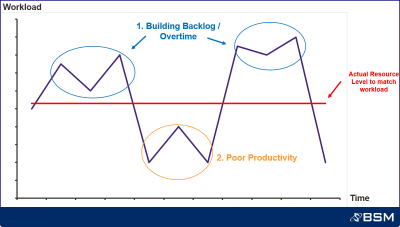Why can't my department get ahead and be productive
In operations where the short interval (e.g. daily or weekly) workload varies, the most common method of distributing the work is to share it equally between the available people. We call this method “available work through available people”. The consequence of this approach is that even low daily workloads expand to fill the day resulting in poor productivity. Carefully designed standard work can improve your department’s performance by consistently making the most out of people’s time.
Consider the situation of the perennially under performing department. Over the last 3 years headcount has increased by 30% but the workload has stayed the same. The allegedly “temporary” staff hired in to help with peak workloads have now been in place for over a year. Even more upsetting is that the departments’ performance and turn around time have not improved despite this increase in staff. They’ve tried dedicating resources to specific tasks and although this improved the output for individual tasks within the department, overall performance did not improve, if anything the metrics got worse. (see Small dedicated work groups). The department has a volatile workload and just can’t seem to get ahead even during sustained lulls in work loads. The problem is that this department is suffering from a phenomenon known as Parkinson's Law: i.e. Work expands so as to fill the time available for its completion.
Consider the following situation. A department with 5 staff, each of whom can contribute 7 work hours per day, has capacity each day for 35 hours work. For the amount of work the department gets each month 5 people should be more than sufficient. But the departments’ performance is not up to scratch. There are constant backlogs and throughput times are not meeting targets. Daily the department receives 25-45 hours of work, but never seems to catch up on itself. A closer inspection of the way the department is organized reveals that each days work is spread evenly among the staff. Available work to available people! While this sounds like the fairest way to distribute work, it is actually one of the reasons that the department is not performing.
Adding staff to improve performance will have limited impact here as the same work load now gets spread among more people giving diminishing returns. This will also increase the percentage of days where the staff are unproductive because the available work is less than the available resource. On top of this, with work spread thinner, people get used to doing less and less so an individual’s work capacity can actually decrease.
The problem with available work to available people is highlighted in the graph below. There are only 3 possibilities:
- The amount of work received is below the capacity of the department, in which case the staff are underutilized and hence unproductive.
- The amount of work received is above the department’s capacity, which carries penalties of increasing backlogs or overtime or both.
- The amount of work matches the department’s capacity. Unless the process has been specifically designed to deliver this amount of work every day (see BSM rhythm wheel, trains, leveling queues), then it is only random luck when the amount of work actually matches the department’s capacity.
Believe it or not there is a way to increase the department’s productivity through careful design. Standard work is one of the keys to unlocking the productivity and performance of this department. Standard work can increase productivity without overloading staff. Standard work is designed to be a productive days work, that fits tasks together in the optimum way so as to make the best use of people’s time. Feedback from staff where standard work is applied is always positive. This is because it is rightly perceived as being fair and balanced and designed to accomplish tasks with the minimum amount of effort.
Imagine in the above situation that the department switches away from available work to available people towards standard work. In this case each employee gets 7 hours of standard work. On days where there are only 25 hours work available, this will occupy 3.6 employee’s, freeing up 1.4 to deal with backlogs, training, improvement projects or long lead time work or projects. In the previous system where work was spread equally among staff, everybody was always occupied. With standard work the department will frequently have “free” resources that can constantly chip away at backlogs or improvement projects. On days where there is more than 35 hours work, the department can guarantee that 35 hours will consistently be delivered, without overburdening staff and the excess can be held over until the next sub 35 hour day.
Of course the right thing to do is to level the workload so that short term volatility is not an issue. BSM have proven methodologies such as rhythm wheels, trains and leveling queues that can level workloads and allow companies to unlock the productivity that is wasted by volatile work loads. When combined with standard work these tools can turn an under performing department into one which is consistently meeting and beating it’s targets.
Our consultants can provide further information on the above and discuss any aspect of Real Lean Transformation, simply set-up a call today.


